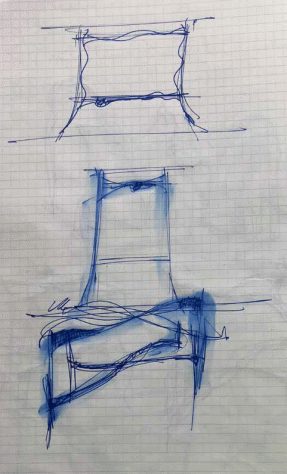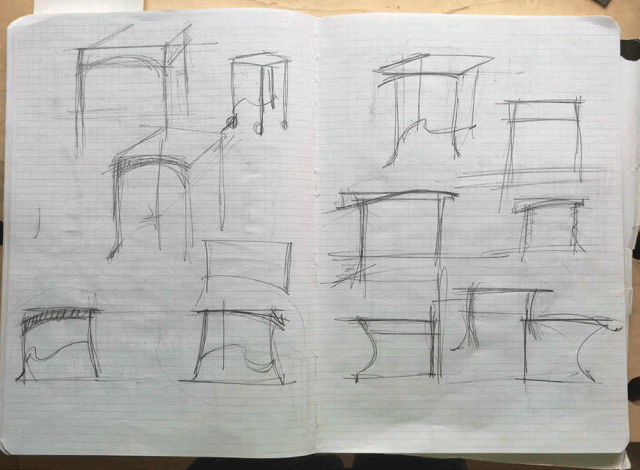 This is an excerpt from “The Intelligent Hand” by David Binnington Savage.
This is an excerpt from “The Intelligent Hand” by David Binnington Savage.
Then the stress starts building. This is important. You are a professional; you need to be able to do this creative stuff on a wet Wednesday when the muse is fast asleep in her pretty little bed. The stress is part of turning up the heat to make you work better. We need a little stress now and again. I have given a delivery date to the client. I have told them I will be with them with drawings that do not yet exist. Next week! I must deliver, or I lose all chance of getting the work. I plan for three days of studio work – no phone, no interruptions and no other jobs in that time frame.
My goal, by the end of day one, is to have one set of presentation drawings done and ready to go. That morning, before tea time, is downloading time. I go through a routine – an important routine. (This is mine; you choose your own.) It sets the tone, and it gets my head ready for this special work.
I sharpen five pencils – not six or four, but five nice cedar pencils. I turn off the phone, I make a cup of coffee, I unplug all the digital things that Ping. I put on a playlist of creative music, stuff with no language that I can understand. Opera is good; I don’t speak Italian. A nice cup of coffee, the dog sitting quietly under the desk and I am ready to roll. All this is “Othering” – doing anything other than sitting down to do the damn drawing. But it’s very valuable, as it signals to a part of the head that Special Creative Work is coming, and there is a guy back there – I call him George – who needs waking up. Get Ready to Rock n’ Roll, George!
So, you sit and doodle (well, that term is rather pejorative; this is a kind of drawing that allows the mind to run free). It’s drawing without too much direction. Watch carefully what comes off the end of the pencil. Do not be critical; note it and move on. This is fluid thinking time. Artist Paul Klee famously called it “taking a line for a walk.”

When I do this, I tend to use a book with a very fine 5mm grid on the page. I get these from a supermarket that imports them from France, where they are used in French schools. The grid helps me to quickly draw in proportion by counting off the squares. It also helps me keep verticals vertical and horizontals …well, you get it. Sometimes, I use a technical .05mm pen instead of a pencil. Pens are great, as they make you draw very deliberately. I almost never use an eraser at this stage.
Writer and comedian John Cleese, when talking about creativity, described how he wrote the scripts for “Monty Python’s Flying Circus.” He was surprised he always had more ideas than his fellow writers, but he found he dug deeper past the first idea.
“I would ideally go into a room with no distractions, that is most important, and sit with a pad and paper. Forty minutes would be a good span. The problem, in my case the requirement for next week’s script, would be there. It would sit alongside me, not confronting me, but be there with me in the room.”
The first ideas that pop out of the pencil are the ones from the front of the head. They are the conscious images, the ideas that you have had before and are reheating for this solution. This is old stuff – and it may be fine. Your client likes you for what you have already done, so a version of that may suit the job in hand. Keep drawing, though – you might get past the obvious first idea to another then another. This is good. Remember, this is non-critical and non-celebratory drawing; just dump the stuff on the damn page. Draw fast and free. Fill a page with quick scribbly images, download and move on.
After about a half-hour I start to find myself repeating things. This is when it’s good to go back, review, find the best sketch and take a break. There is no point going on, breaking yourself over this problem. Note when you are done and stop. This kind of work – this downloading – is exhausting, even to the young and strong.
— Meghan B.